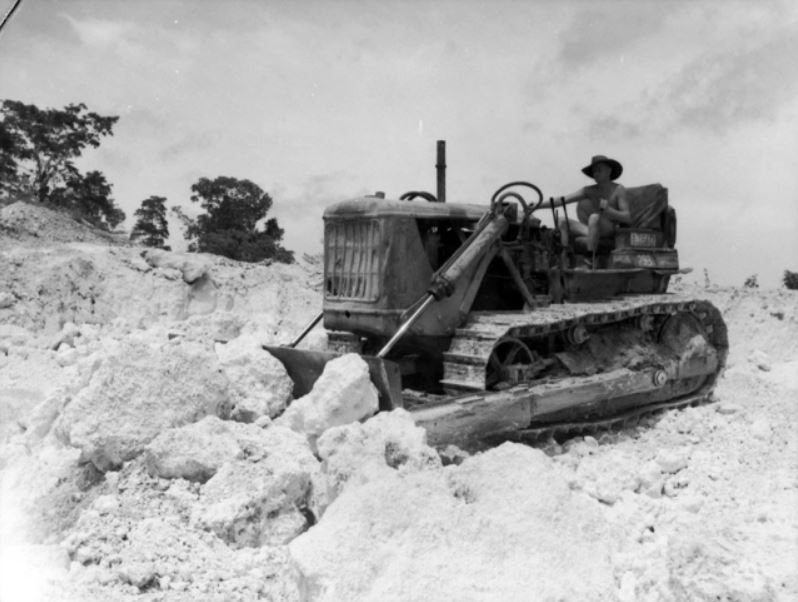No. 5 Airfield Construction Squadron RAAF
From Our Contribution
Revision as of 21:16, 10 November 2020 by Linton (talk | contribs) (Linton moved page No 5. Airfield Construction Squadron RAAF to No. 5 Airfield Construction Squadron RAAF without leaving a redirect)
 A No. 5 Airfield Construction Squadron bulldozer working in a coral quarry at Noemfoor Island during December 1944 | |
 | |
Contents
Brief History
No. 5 Airfield Construction Squadron aka "The Flying Shovels", began life as an offshoot of 1 Mobile Works Squadron when it was decided that there was a requirement for construction support in New Guinea. The new unit, was formed at Ascot Vale on 7 Jul 1942 using men from 1 Mobile Works Station. One month later the Squadron disembarked at Port Moresby, with its first task to complete airfield construction at Wards Strip. Considerable effort had to be expended to improve drainage, as the soil was a fine grey clay, which became th1ck mud at the hint of rain.
In mid-November 1942 the Special Works Squadron was re-named 5 Mobile Works Squadron. In March of 1943 a detachment was sent to Milne Bay to assist 6 Mobile Works Squadron, while the remainder of the unit prepared to move to Goodenough Island. On Goodenough the Squadron was engaged in the construction of the Vivigani strip, using preformed steel. Following the completion of its tasks on Goodenough, the Squadron sailed south for rest and recuperation. After a break of one month, 5 Mobile Works Squadron reformed and returned to New Guinea, landing after the assault forces at Aitape on the northern coast. There, the unit made the Tadji strip operational. The next move was to Noemfoor Island, where the Squadron assisted American and British construction units in the construction of two 7000-foot runways. While manning the perimeter defences, the Squadron captured 12 Japanese infiltrators.
As of 18 July 1944, the Squadron became known as No. 5 Airfield Construction Squadron. While at Kornasoran, four members of the Squadron had won awards for rescuing the crew of a plane that crashed into a lagoon soon after take off. One was awarded the British Empire Medal and the other three were Mentioned in Despatches. In late 1944, the unit moved to nearby Biak Island, where work was required on Sorido, Borokoe and Mokmer strips. There the unit remained until 10 June 1945, when it followed the assault troops onto the beaches of Labuan. Its main goal was the rehabilitation of the Labuan airfield.
Following the capitulation of the Japanese, 5 Airfield Construction Squadron became part of the occupation force on the Japanese mainland. The Squadron embarked on Landing Ship Tanks, for the destination of Iwakuni. There the unit occupied a disused sea plane base and converted the remaining hangars to workshops and equipment stores. Although under-manned, the unit was tasked to assist with many jobs which were not strictly within the realms of an a airfield construction squadron. The unit remained in Japan for a further three years until 30 Jun 1949 when it was disbanded in the field.
Squadron Personnel
- Francis Neal McGurk 1 Mar 1944 - 20 Sep 1945
Battle Honours
Individual Honours
Notes